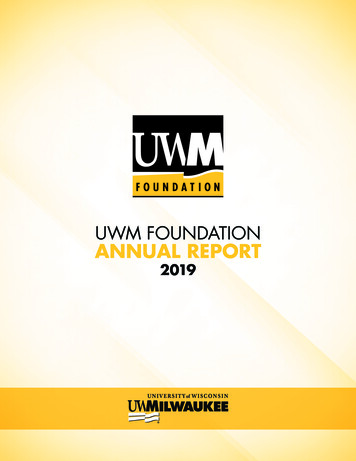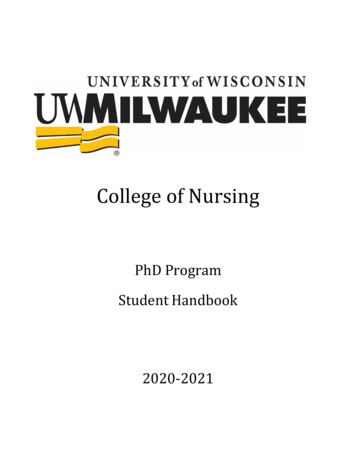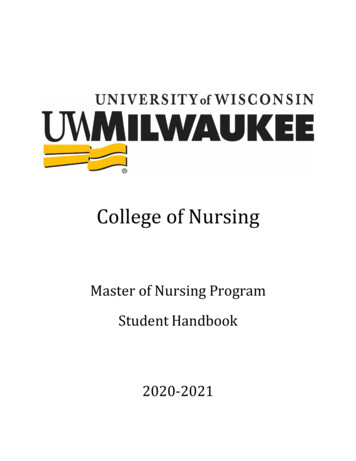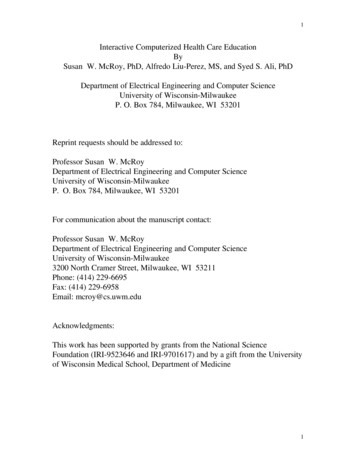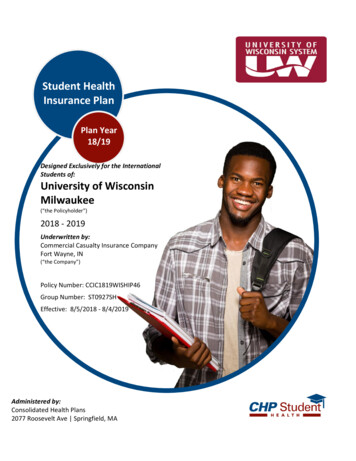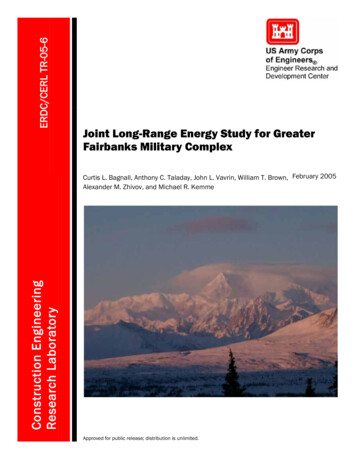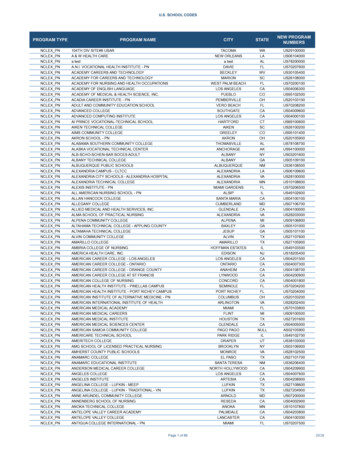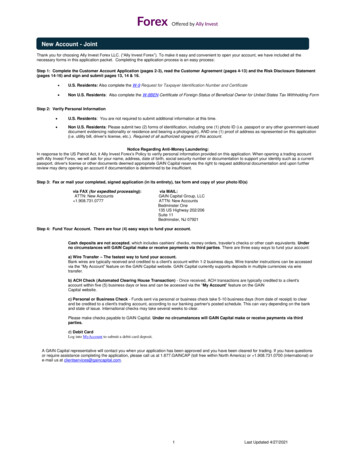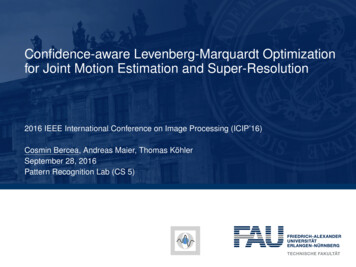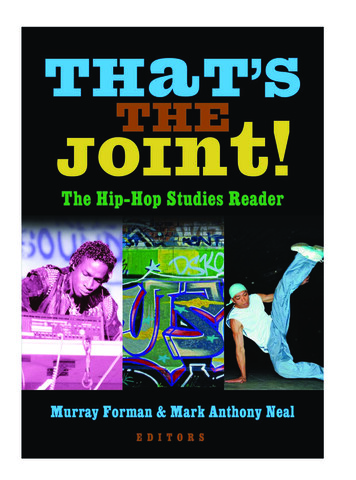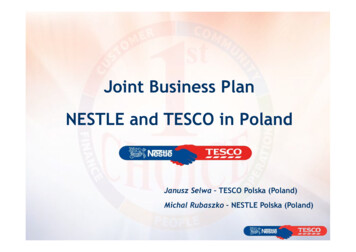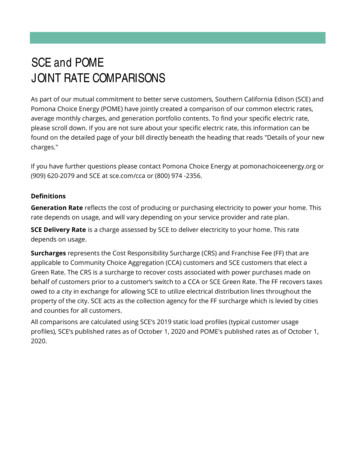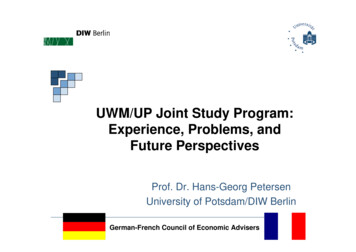
Transcription
UWM/UP Joint Study Program:Experience, Problems, andFuture PerspectivesProf. Dr. Hans-Georg PetersenUniversity of Potsdam/DIW BerlinGerman-French Council of Economic Advisers
ContentsI.II.IntroductionHistorical Background, Challenges and ObstaclesII.1. Brief HistoryII.2. Challenges and Obstacles- Term Structures- Academic Degrees and Study Programs- Tuition Fees- Language BarriersIII.IV.V.VI.2Curriculum, Program Structures and ParticipationFuture Perspective: Mutuality and IntegrationRemaining Problems and Cultural DifferencesSummaryProf. Dr. H.-G. Petersen
I.Introduction400 YEARS198716 YEARS19973Prof. Dr. H.-G. Petersen
II. Historical Background,Challenges and ObstaclesBrief History1987: Staff exchange JLU and UWM1989: First JLU students at the UWM, supported by the IAS Program of DAADImplementation of the Giessen Summer Course for UWM Students supportedby the Albert-Oswald Foundation1997: First UP students at the UWM, supported by the IASP Program of the DAAD2000: First UP student as teaching assistant at the UWM2004: First PhD student from the UP at the UWM2005: Partnership contract in between the UWM and the UP2005: First UWM students participating in the Potsdam Summer Academy (PoSA)implemented in 2004 with support of the DAAD (German Summer AcademiesProgram)2006: First self-paying PU students at the UWM2007: 10th anniversary of the UWM/UP exchange4Prof. Dr. H.-G. Petersen
II. Historical Background,Challenges and ObstaclesCultural and administrative differencesProfessional administrative structures (UWM)versuscooperative self-administration of professors (UP)Autonomy and self-responsibility (UWM)versusbureaucratic steering by ministry (UP)extended negotiations and a long processof developing mutual confidence5Prof. Dr. H.-G. Petersen
II. Historical Background,Challenges and ObstaclesDifferent periodical term structuresUWM: Winter term September to DecemberSpring term January to MaySummer session June to AugustUP:Winter term October 15 to February 15Winter break February 16 to April 14Summer term April 15 to July 15Summer break July 16 to October 14Overlapping of the terms for 6/ 9 weeks6Prof. Dr. H.-G. Petersen
II. Historical Background,Challenges and ObstaclesDifferent periodical term structuresEasy solution in case of unidirectional exchange for the German studentsSerious problems in case of mutual exchange:Start of the German study program for UWM students at a later date and teaching the course programin a condensed mode (organizational problems, room problems, additional burden for the students,etc.)Extending the summer term for six weeks (summer course program), which is in conflict with theprevailing vacation time in EuropeDisadvantages for the teaching staff in Germany (no recognition for the teaching load of the singleprofessor, no related remuneration, reduced time for own research, just an individual“Freizeitvergnügen”In a “tuition free world” more (international) students are an additional burden while in the US eachstudent directly contributes to the faculties budgetsInternational students are more demanding than German because of the better teacher/studentrelation they are used to haveThe US course structure is much more class room oriented and lecturer steered than a German“Vorlesung”, which demands self-depending learning and study organization from the students withoutprecise homework7Prof. Dr. H.-G. Petersen
II. Historical Background,Challenges and ObstaclesDifferences of academic degrees,length of the respective study programsUSA:BA after four years study programGermany:Pre-diploma after two years (four terms) basic study programDiploma after 4.5 years (five terms) main study programProblem:Which degree is equivalent to the BA?Solution:Third year on high school pre-diploma two terms in the main study program BA equivalence8Prof. Dr. H.-G. Petersen
II. Historical Background,Challenges and ObstaclesDifferences of academic degrees,length of the respective study programsThe Bologna process has created a new problem:European BA after three years study programProblems with the MA are much less serious because at theUS universities the contents of most study programs aredefined by credit points and not by completed terms(favouring part-time study). The UP students complete theirUWM degree within two terms (September until May in thefollowing year). Recently more and more students without athird year on high school have been accepted by thegraduation office.9Prof. Dr. H.-G. Petersen
II. Historical Background,Challenges and ObstaclesTuition FeesUSA:Tuition fees at all universities (fees at private unisgenerally higher than at state unis)UWM:Graduate program feesNon-residents fees per term:Residents (in-state) fees per term:11,645.90 USD4,462.94 USDThe UP students have contributed about 107,000 USD in tuition feesat the UWM (with regard to the JLU students this amount is doubled.In total (taking the current amounts) the UP students have paid morethan 500.000 USD, which means that the German students arefinancing a remarkable part of the program costs at the UWM.10Prof. Dr. H.-G. Petersen
II. Historical Background,Challenges and ObstaclesTuition FeesGermany:In most of the federal states no tuition fees areraised.In 2007 to 2008 the following states will introduce tuition feeswith the maximum amount of 500 Euros per term (ceilingrecently determined by the Constitutional Court):Baden-Wuertemberg, Bavaria, Hamburg, Lower Saxony, NorthRhine Westphalia, and Saarland.10 of 16 states have tuition fees for students with study periodsabove the standard study length (predominantely about 500 Eurosper term, maximum 650 Euros in NRW)11Prof. Dr. H.-G. Petersen
II. Historical Background,Challenges and ObstaclesLanguage BarriersOnly demand for English programs in GermanyEven then at a single US university the demand is very limited:Large internal labor market.Supra-national integration does not play animportant role.Minimizing study length due to tuition fees.Net return of prolonged study times minor becausestudy abroad is not jet enough evaluated in thelabor markets.But:Substantial changes are ahead because withgrowing competition the knowledge of foreignmanagement and marketing strategies will becomemuch more profitable.Even the internal US markets will become relativesmall compared to that in China and India.12Prof. Dr. H.-G. Petersen
III. Curriculum, Program Structuresand ParticipationFocus on the Graduate Study ProgramsUWM:Labor Economics415 Economics of Employment & Labor Relations447 Labor Economics751 Labor Economics I752 Labor Economics II753 Collective Bargaining754 Worker Participation. 3755 Comparative Labor Markets and Employment Relations955 Seminar: Labor Economics. (Subtitled)Development Economics454 International Trade455 International Finance712 Urban Economic Theory713 Regional Economic Theory774 Economic Development - Theory775 Economic Development - PolicyAccreditation of courses at the UP:Courses up to 14 term hours (seven courses) are approved so thatthe students can skip at least one subject (out of five; e.g., inBusiness: General Economics)13Prof. Dr. H.-G. Petersen
III. Curriculum, Program Structuresand ParticipationFocus on the Graduate Study Programs at the UPFinancial Markets:Public Economics: Monetary theoryMonetary policyMonetary foreign trade theorySpecial macroeconomics Banking: Banking IBanking IIAnalysis of the capital marketAdvanced seminar bankingPublic economics and state theorySocial economics – theory and practice ofsocial securitySocial policy and private insuranceTax and transfer systems in theory andpracticePoSA: Banking, Insurance and the Public Sector:Empirical experience and policy adviceInsurance Markets: 14Insurance management IInsurance management IIRisk managementProf. Dr. H.-G. Petersen
III. Curriculum, ProgramStructures and ParticipationProblems of the switch to BA/MA structures in Germany:Instead of subjects (e.g., economic theory, economic policy, publicfinance) study modules (less than 1/3 of a former subject), whichespecially in case of business students make the exchange moredifficultDisintegration of study programs (e.g., business and economics)and loss in interdisciplinaryProlongation of study timesLength of study programs and additional tuition fees are currentlyleading to less students mobility in Germany (HIS in DHV:Forschung und Lehre 4/2007)15Prof. Dr. H.-G. Petersen
III. Curriculum, ProgramStructures and ParticipationTable 1: Outgoing students and financial sources 102007/08224412Total2215147583Prof. Dr. H.-G. Petersen
III. Curriculum, ProgramStructures and ParticipationHappy Masters in Economics17Prof. Dr. H.-G. Petersen
III. Curriculum, ProgramStructures and ParticipationUWM Graduation Ceremony 2005Graduation Ceremony 199818Prof. Dr. H.-G. Petersen
IV. Future Perspective:Mutuality and IntegrationProblems:Balancing incoming and outgoing studentsNo similar support programs for students in the USCost pressures and part-time study limit the interestof US students for study programs abroadIntroduction of a sufficient study program in Englishat the UP19Prof. Dr. H.-G. Petersen
IV. Future Perspective:Mutuality and IntegrationFurther development:1. Switch to BA/MA structures has delayed further negotiations2. Combination of MA and PhD programs at the UWM and UP3. Compliance of formal rules (study periods) at the own university solved byflexible staff exchange (teaching own courses at the partner university)4. Harmonized conditions for admission (joint commission)5. TOEFL-Test and basic German language program for incoming studentsat the UP6. Intensified staff exchange7. US and German Degrees, annotations in form of a diploma supplement8. Partial reduction of tuition fees especially for DAAD scholars9. Exchange based on the IASP program of the DAAD10. Admittance of about five students from each partner university or integratingother US partner universities to guarantee such a number11. Extend the exchange to business administration and social sciences20Prof. Dr. H.-G. Petersen
V. Remaining Problems andCultural DifferencesGerman View:-21International student exchange as inherent value(openness of the society)Vehicle to international and global integration (e.g.,European integration)Promotion for international reputation via educating thecoming opinion leadersMarketing for Made in Germany andEducated in GermanySecuring the future of the German export markets bysupport of scholarsInvesting the peace dividend stemming from the EUintegrationProf. Dr. H.-G. Petersen
V. Remaining Problems andCultural DifferencesAnglo-Saxon View (?):- Focus on the internal labor markets- Incoming foreign students taken as payers of non-residents fees(financial aspect): users pay concept (short-termed)- “Education industry” (Australia)- Marketing the university like a brand- “Professional” university management by decreasing influence ofthe professorsPossible outcome (at least in several bad examples):- Undermining the scientific qualifications of the teaching staff(Business schools without professors but only lecturers)- Downgrading of study programs- Trading academic degrees- Closing down subjects, which are not market oriented enough- Sacrificing the character of the University and destroyinginterdisciplinary22Prof. Dr. H.-G. Petersen
VI. SummaryInternational programs are based upon individual linksand confidence in between the colleagues, which cannotbe substituted by institutional rules (e.g., Bologna)!International students exchange is the prerequisite formutual understanding and a peaceful future!Hence, higher education financing cannot only relyupon the users pay principle!Sans Soucie Palace at nightThanks for your attention!23Prof. Dr. H.-G. Petersen
Implementation of the Giessen Summer Course for UWM Students supported by the Albert-Oswald Foundation 1997: First UP students at the UWM, supported by the IASP Program of the DAAD 2000: First UP student as teaching assistant at the UWM 2004: First PhD student from the UP at the UWM 2005: Partnershi
